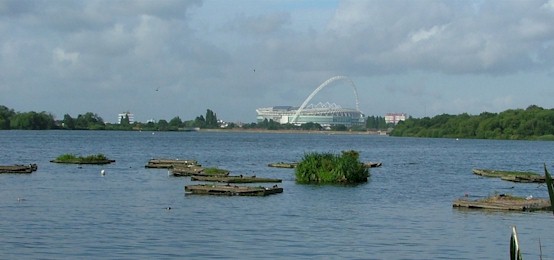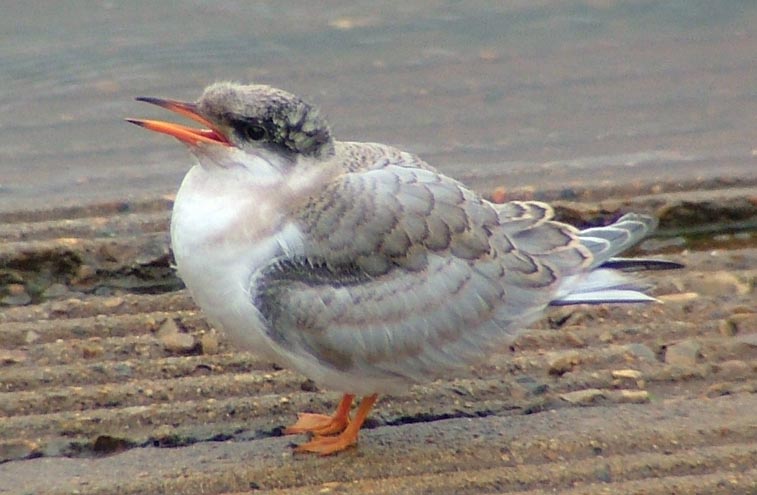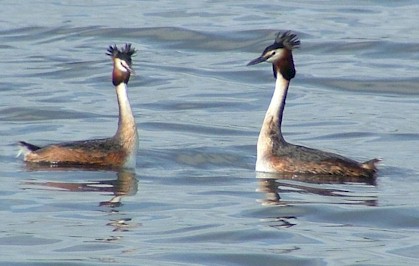Brent Reservoir
From Londonbirders
(→Directions) |
m |
||
| (12 intermediate revisions not shown) | |||
| Line 1: | Line 1: | ||
| - | + | [http://www.streetmap.co.uk/map.srf?X=521620&Y=187495&A=Y&Z=110 Map] | |
| + | |||
Website: [http://www.brentres.com http://www.brentres.com] | Website: [http://www.brentres.com http://www.brentres.com] | ||
== Directions == | == Directions == | ||
| - | |||
| - | [[Image: | + | [[Image:Brentphoto.jpg|right]] |
| - | + | Also commonly known as the Welsh Harp, Brent Reservoir is a large reservoir with natural banks lying adjacent to the North Circular Road in Neasden and surrounded by marshland, woodland, unimproved grassland and playing fields. The main point of access is off West Hendon Broadway NW9 along Cool Oak Lane. You can park just before the bridge which crosses the reservoir or there is a car park at the top of Woodfield Park. NB. On weekdays there is no parking on Woolmead Avenue and other local roads between 10.00-11.00. | |
| + | |||
| + | For access using public transport the closest station to the hides is Hendon rail station (Thameslink), which is a 10-minute walk away: turn right out of station, walk down Station Road and left at the end onto West Hendon Broadway, crossing over to go down Cool Oak Lane. If arriving by London Underground, head for Hendon Central (Northern Line) and cross Queens Road to catch bus 83 to West Hendon Broadway, or go to Wembley Park (Metropolitan and Jubilee Lines) and take bus 297 or 182 to Blackbird Hill, getting off at the stop opposite Lidl and walking along Birchen Grove to the dam (western) end of the reservoir. West Hendon Broadway is also served by buses 32, 142 and 183 and Blackbird Hill by buses 182, 245 and 302. Route 112 follows the North Circular Road (A406) past the south side of the reservoir. | ||
== Access == | == Access == | ||
| - | There is open access to all of the reservoir although a key is required to access the hides. There are two hides overlooking East Marsh (follow the footpath which starts by the sailing base car park | + | There is open access to all of the reservoir although a key is required to access the hides. There are two hides overlooking East Marsh ([http://www.streetmap.co.uk/map.srf?X=522077&Y=187467&A=Y&Z=115 Main Hide]; [http://www.streetmap.co.uk/map.srf?X=522177&Y=187437&A=Y&Z=115 Heron Hide]). To reach them follow the footpath which starts by the defunct sailing base car park next to the Cool Oak Lane bridge. In the North Marsh is a third hide (currently closed) with a raised viewing platform nearby ([http://www.streetmap.co.uk/map.srf?X=521650&Y=187850&A=Y&Z=115 map]). To reach them, follow the footpath north from the west side of Cool Oak Lane bridge. |
| + | |||
| + | A good circular walk starts at the Cool Oak Lane bridge and follows the north bank of the main reservoir towards the dam end. After 20 metres there is a viewing platform that looks over the main reservoir. Other view points over this reservoir are near a jetty opposite a sailing club, and from the Bomb Crater Pond. When you reach the car park by the dam, follow the tarmac path back east along the top end of the large grassy field (Shrike Field). After the path bends to the left and a school appears on your left, look for an obvious gap in the hedge on the right hand side which leads out to playing fields. Walk up the playing field to the road and cross over. Follow the signpost towards Silver Jubilee Park and walk around the top football pitch towards the gorse patch. Take one of the paths that lead down the slope to West Hendon Playing Fields. You will see a large area of rough grass on the right. Take the footpath that cuts through the middle of it and turn right onto another path. This area is known as the Dump and is good for migrants. Follow the path down a slope towards the Northern Reservoir where you will find a viewing platform, then continue along the path, checking the old allotments on your right, until you find yourself back at Cool Oak Lane bridge. | ||
| + | |||
There is an active conservation group from whom a key for the hides is obtainable, telephone 020 8447 1810). | There is an active conservation group from whom a key for the hides is obtainable, telephone 020 8447 1810). | ||
| + | |||
| + | [[Image:Brentres1.jpg]] | ||
| + | |||
| + | '''View from the hide looking towards the dam with Wembley Stadium in the background''' (Photo by Andrew Self) | ||
== History == | == History == | ||
| Line 27: | Line 36: | ||
== Breeding Birds == | == Breeding Birds == | ||
| - | Mute Swan, Canada Goose, Gadwall, Mallard, Shoveler (occasionally), Pochard, Tufted Duck, Ruddy Duck, Little Grebe, Great Crested Grebe, Sparrowhawk, Kestrel, Moorhen, Coot, Lesser Black-backed Gull, Herring Gull, Common Tern, Feral Dove, Stock Dove, Woodpigeon, Collared Dove, Tawny Owl, Swift, Kingfisher, Green Woodpecker, Great Spotted Woodpecker, House Martin, Grey Wagtail, Pied Wagtail, Wren, Dunnock, Robin, Blackbird, Song Thrush, Mistle Thrush, Sedge Warbler, Reed Warbler, Lesser Whitethroat, Common Whitethroat, Garden Warbler, Blackcap, Willow | + | Mute Swan, Canada Goose, Gadwall, Mallard, Shoveler (occasionally), Pochard, Tufted Duck, Ruddy Duck, Little Grebe, Great Crested Grebe, Sparrowhawk, Kestrel, Moorhen, Coot, Lesser Black-backed Gull, Herring Gull (occasionally), Common Tern, Feral Dove, Stock Dove, Woodpigeon, Collared Dove, Tawny Owl, Swift, Kingfisher, Green Woodpecker, Great Spotted Woodpecker, House Martin, Grey Wagtail, Pied Wagtail, Wren, Dunnock, Robin, Blackbird, Song Thrush, Mistle Thrush, Sedge Warbler, Reed Warbler, Lesser Whitethroat, Common Whitethroat, Garden Warbler, Blackcap, Willow Warbler, Chiffchaff, Goldcrest, Long-tailed Tit, Blue Tit, Great Tit, Coal Tit, Jay, Magpie, Carrion Crow, Starling, House Sparrow, Chaffinch, Greenfinch, Goldfinch, Bullfinch, Reed Bunting. |
[[Image:AS_GCGrebe.jpg]] | [[Image:AS_GCGrebe.jpg]] | ||
Current revision as of 11:13, 8 December 2009
Website: http://www.brentres.com
Contents |
Directions
Also commonly known as the Welsh Harp, Brent Reservoir is a large reservoir with natural banks lying adjacent to the North Circular Road in Neasden and surrounded by marshland, woodland, unimproved grassland and playing fields. The main point of access is off West Hendon Broadway NW9 along Cool Oak Lane. You can park just before the bridge which crosses the reservoir or there is a car park at the top of Woodfield Park. NB. On weekdays there is no parking on Woolmead Avenue and other local roads between 10.00-11.00.
For access using public transport the closest station to the hides is Hendon rail station (Thameslink), which is a 10-minute walk away: turn right out of station, walk down Station Road and left at the end onto West Hendon Broadway, crossing over to go down Cool Oak Lane. If arriving by London Underground, head for Hendon Central (Northern Line) and cross Queens Road to catch bus 83 to West Hendon Broadway, or go to Wembley Park (Metropolitan and Jubilee Lines) and take bus 297 or 182 to Blackbird Hill, getting off at the stop opposite Lidl and walking along Birchen Grove to the dam (western) end of the reservoir. West Hendon Broadway is also served by buses 32, 142 and 183 and Blackbird Hill by buses 182, 245 and 302. Route 112 follows the North Circular Road (A406) past the south side of the reservoir.
Access
There is open access to all of the reservoir although a key is required to access the hides. There are two hides overlooking East Marsh (Main Hide; Heron Hide). To reach them follow the footpath which starts by the defunct sailing base car park next to the Cool Oak Lane bridge. In the North Marsh is a third hide (currently closed) with a raised viewing platform nearby (map). To reach them, follow the footpath north from the west side of Cool Oak Lane bridge.
A good circular walk starts at the Cool Oak Lane bridge and follows the north bank of the main reservoir towards the dam end. After 20 metres there is a viewing platform that looks over the main reservoir. Other view points over this reservoir are near a jetty opposite a sailing club, and from the Bomb Crater Pond. When you reach the car park by the dam, follow the tarmac path back east along the top end of the large grassy field (Shrike Field). After the path bends to the left and a school appears on your left, look for an obvious gap in the hedge on the right hand side which leads out to playing fields. Walk up the playing field to the road and cross over. Follow the signpost towards Silver Jubilee Park and walk around the top football pitch towards the gorse patch. Take one of the paths that lead down the slope to West Hendon Playing Fields. You will see a large area of rough grass on the right. Take the footpath that cuts through the middle of it and turn right onto another path. This area is known as the Dump and is good for migrants. Follow the path down a slope towards the Northern Reservoir where you will find a viewing platform, then continue along the path, checking the old allotments on your right, until you find yourself back at Cool Oak Lane bridge.
There is an active conservation group from whom a key for the hides is obtainable, telephone 020 8447 1810).
View from the hide looking towards the dam with Wembley Stadium in the background (Photo by Andrew Self)
History
The reservoir was completed in 1840 and the birdlife has been recorded since then (in fact it was 'birded' i.e. birds were shot during its construction). With such a long history inevitably it has an impressive list of rarities, such as the UK's first Iberian Chiffchaff in 1972. Other rarities include White-rumped Sandpiper, Hume's Warbler, Lesser Scaup, Blue-winged Teal and Great White Egret.
The site was designated an SSSI for its breeding wetland birds such as Great Crested Grebe, Pochard, Tufted Duck and Common Tern and is also now a Local Nature Reserve.
A recently fledged Common Tern at Brent Res (Photo by Andrew Self)
Breeding Birds
Mute Swan, Canada Goose, Gadwall, Mallard, Shoveler (occasionally), Pochard, Tufted Duck, Ruddy Duck, Little Grebe, Great Crested Grebe, Sparrowhawk, Kestrel, Moorhen, Coot, Lesser Black-backed Gull, Herring Gull (occasionally), Common Tern, Feral Dove, Stock Dove, Woodpigeon, Collared Dove, Tawny Owl, Swift, Kingfisher, Green Woodpecker, Great Spotted Woodpecker, House Martin, Grey Wagtail, Pied Wagtail, Wren, Dunnock, Robin, Blackbird, Song Thrush, Mistle Thrush, Sedge Warbler, Reed Warbler, Lesser Whitethroat, Common Whitethroat, Garden Warbler, Blackcap, Willow Warbler, Chiffchaff, Goldcrest, Long-tailed Tit, Blue Tit, Great Tit, Coal Tit, Jay, Magpie, Carrion Crow, Starling, House Sparrow, Chaffinch, Greenfinch, Goldfinch, Bullfinch, Reed Bunting.
Pair of Great Crested Grebes displaying at Brent Res (Photo by Andrew Self)




